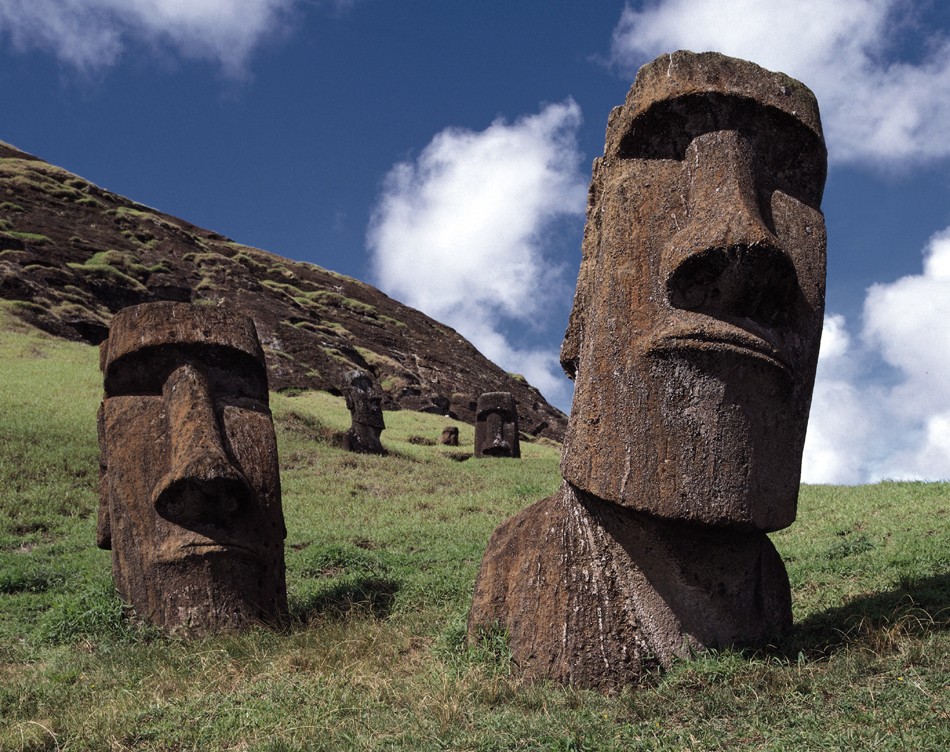


An online article on Reuters by Will Dunham - Easter Island's ancient inhabitants weren't so lonely after all - suggests that the ancient Polynesian people who populated Easter Island, or Rapa Nui, were not as isolated as long believed.

Despite the island's remoteness - 2,300 miles (3,700 km) west of South America and 1,100 miles (1,770 km) from the closest island - scientists who conducted a genetic study, published in the journal Current Biology, found these ancient people had significant contact with Native American populations hundreds of years before the first Westerners reached the island in 1722.
The Rapa Nui people are known for many reasons, but perhaps the most obvious is the creation of the 900 or so monumental moai sculptures erected around the island. The culture flourished starting around 1200 until falling into decline by the 16th century.
Genetic data on 27 Easter Island natives indicated that interbreeding between the Rapa Nui and native people in South America occurred roughly between 1300 and 1500. This gene flow between Rapa Nui and Native American populations points to ancient ocean migration routes between Polynesia and the Americas, according to geneticists Anna-Sapfo Malaspinas of the Center for GeoGenetics at the University of Copenhagen and Mark Stoneking of Germany's Max Planck Institute for Evolutionary Anthropology. They believe it was probably the Rapa Nui people making the arduous ocean journeys, almost certainly in wooden outrigger canoes.
Further research is being planned, but already they have concluded that the intermixing occurred 19 to 23 generations ago. Rapa Nui people are not believed to have started mixing with Europeans until much later in the 19th century. The genetic ancestry of today's Rapa Nui people is roughly 75 percent Polynesian, 15 percent European and 10 percent Native American.
Simultaneously, a study, also published in Current Biology, illustrates another case of Polynesians venturing into South America. Two ancient human skulls from Brazil's indigenous Botocudo people, known for the large wooden disks they wore in their lips and ears, belonged to people who were genetically Polynesian, with no detectable Native American ancestry. This means the Polynesians reached South America and made their way to Brazil, either landing on the western coast of the continent and crossing the interior or voyaging around Tierra del Fuego and up the east coast.
Editor's Note:
Genetic research is developing rapidly, and results are coming in that are causing pain and paradigm shifts. Archaeologists, anthropologists and ethnologists, as well as geneticists, are being presented with new and compelling evidence that is re-shaping our understanding of prehistory. One element of this is the extent and degree of early sea-faring navigation.
To view the Easter Island section:
http://www.bradshawfoundation.com/easter/index.php
To view the research and adventures of Thor Heyerdahl - Feasible Ocean Routes in Pre-Columbian Times:
http://www.bradshawfoundation.com/thor/ocean-routes.php
Read about early sea-faring navigation in 'Beyond the Blue Horizon: How the Earliest Mariners Unlocked the Secrets of the Oceans' by Brian Fagan. We know the tales of Columbus and Captain Cook, yet much earlier mariners made equally bold and world-changing voyages. In Beyond the Blue Horizon, archaeologist and historian Brian Fagan tackles his richest topic yet: the enduring quest to master the oceans, the planet's most mysterious terrain. From the moment when ancient Polynesians first dared to sail beyond the horizon, Fagan vividly explains how our mastery of the oceans changed the course of human history. What drove humans to risk their lives on open water? How did early sailors unlock the secrets of winds, tides, and the stars they steered by? What were the earliest ocean crossings like? With compelling detail, Fagan reveals how seafaring evolved so that the forbidding realms of the sea gods were transformed from barriers into a nexus of commerce and cultural exchange. From bamboo rafts in the Java Sea to triremes in the Aegean, from Norse longboats in the North Atlantic to sealskin kayaks in Alaska, Fagan crafts a captivating narrative of humanity's urge to challenge the unknown and seek out distant shores.
http://www.bradshawfoundation.com/books/beyond_the_blue_horizon.php
Comment
by Bradshaw Foundation
Monday 04 December 2023
by Bradshaw Foundation
Friday 30 June 2023
by Bradshaw Foundation
Thursday 06 April 2023
by Bradshaw Foundation
Thursday 24 November 2022
by Bradshaw Foundation
Tuesday 27 September 2022
by Bradshaw Foundation
Thursday 08 September 2022
by Bradshaw Foundation
Tuesday 19 July 2022
by Bradshaw Foundation
Monday 06 June 2022
by Bradshaw Foundation
Friday 11 March 2022
by Bradshaw Foundation
Wednesday 02 March 2022
by Bradshaw Foundation
Thursday 26 August 2021
by Bradshaw Foundation
Monday 16 August 2021
by Bradshaw Foundation
Tuesday 06 July 2021
by Bradshaw Foundation
Thursday 06 May 2021
by Bradshaw Foundation
Thursday 06 May 2021
by Bradshaw Foundation
Tuesday 16 March 2021
by Bradshaw Foundation
Monday 04 December 2023
by Bradshaw Foundation
Friday 30 June 2023
by Bradshaw Foundation
Thursday 06 April 2023
by Bradshaw Foundation
Thursday 24 November 2022
by Bradshaw Foundation
Tuesday 27 September 2022
by Bradshaw Foundation
Thursday 08 September 2022
by Bradshaw Foundation
Tuesday 19 July 2022
by Bradshaw Foundation
Monday 06 June 2022
by Bradshaw Foundation
Friday 11 March 2022
by Bradshaw Foundation
Wednesday 02 March 2022
by Bradshaw Foundation
Thursday 26 August 2021
by Bradshaw Foundation
Monday 16 August 2021
by Bradshaw Foundation
Tuesday 06 July 2021
by Bradshaw Foundation
Thursday 06 May 2021
by Bradshaw Foundation
Thursday 06 May 2021
by Bradshaw Foundation
Tuesday 16 March 2021
Friend of the Foundation











